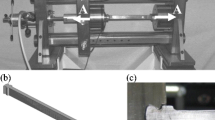Abstract
A special test facility was constructed for evaluating the fatigue strength of turbine-blade components under steady pullout and vibratory bending loadings. The use of mechanical resonance for these applications was particularly attractive in that failure in inaccessible areas could be detected by the change in natural frequency of the specimen. The sensitivity of the method allowed determination of a fatigue crack as early in life as possible. The application of this facility to the determination of the fatigue strength of a type of riveted connection employed on certain types of blades is described in this paper. A steady load representing the centrifugal force was applied hydraulically through a long flexible pullrod which in combination with the test specimen was excited laterally at its resonant frequency by an electromagnetic shaker. An accelerometer provided closed-loop control on both vibration amplitude and resonant frequency through special circuitry. Fatigue-strength reduction factors at 107 cycles were determined for three types of riveted test specimens in air at room temperature. These values exceeded the elastic stress-concentration factors estimated from earlier photoelastic tests for all three cases.
Similar content being viewed by others
References
Unholtz, K., “Vibration Testing Machines,”Shock and Vibration Handbook, ed. by C.M. Harris andC.E. Crede, McGraw Hill Book Co., NY, Ch. 25,2,66–69 (1961).
Dolan, T.J., “Electrically Excited Resonant-Type Fatigue Testing Equipment,” ASTM Bulletin (July 1951).
Wozney, G.P., “Resonant-vibration Fatigue Testing,”Experimental Mechanics,2 (1),1–8 (Jan. 1962).
Marloff, R.H., “Stresses in Turbine-blade Tenons Subjected to Bending,”Experimental Mechanics,18 (1),19–24 (Jan. 1978).
Dowling, N.E., Brose, W.R. and Wilson, W.K., “Notched Member Fatigue Life Predictions by the Local Strain Approach,” Fatigue Under Complex Loading-Analysis and Experiments, AE-6, Soc. of Auto. Engrs. (Sept. 1977).
Neuber, H., “Theory of Stress Concentration for Shear-Strained Prismatical Bodies with Arbitrary Nonlinear Stress-Strain Law,”J. of Appl. Mech., Trans. ASME,28,544–550 (Dec. 1961).
Stadnick, S.J. and Morrow, J., “Techniques for Smooth Specimen Simulation of the Fatigue Behavior of Notched Members,” Testing for Prediction of Material Performance in Structures and Components, STP 515, Amer. Soc. for Test. and Matls, 229–252 (1972).
Author information
Authors and Affiliations
Rights and permissions
About this article
Cite this article
Marloff, R.H. Resonant fatigue testing of riveted joints. Experimental Mechanics 20, 37–43 (1980). https://doi.org/10.1007/BF02321032
Received:
Revised:
Issue Date:
DOI: https://doi.org/10.1007/BF02321032




